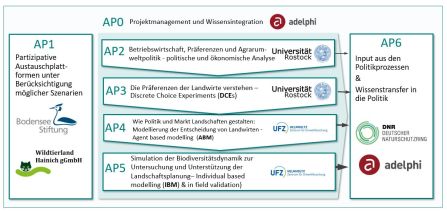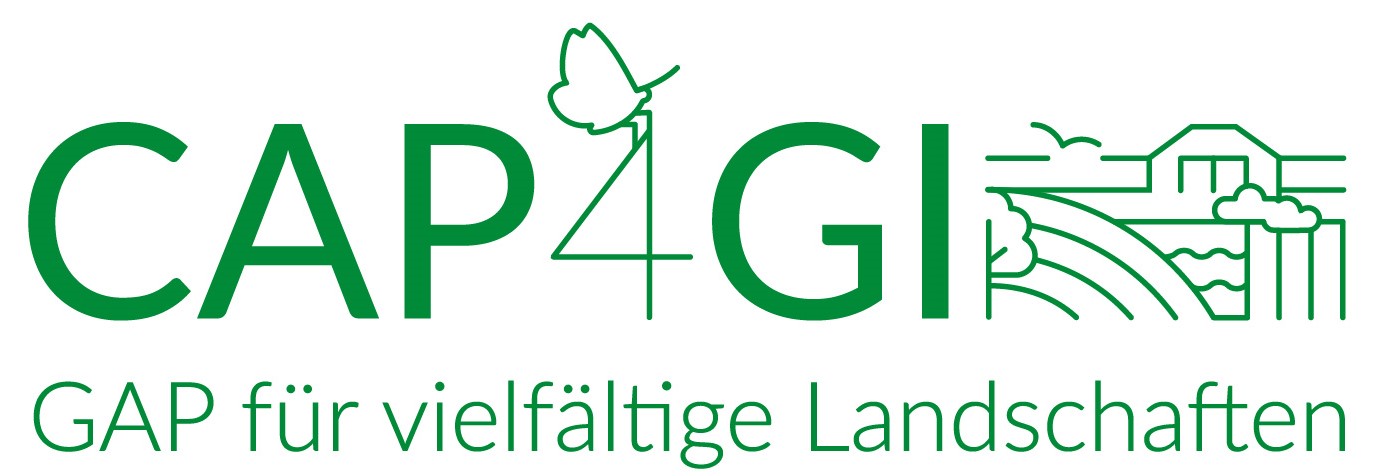
WP0 - Project management and knowledge integration
Within work package 0, adelphi ensures the inter- and transdisciplinary coordination of CAP4GI. This includes a variety of tasks:
- Organization of internal communication and collaboration, e.g., through regular online meetings of the project team;
- Organizing annual meetings of the entire consortium, to strengthen internal collaboration, to work on complex cross-project issues, and more.
- Establishment of an expert advisory board that critically accompanies the implementation of the project and brings in expertise from the fields of landscape conservation, agricultural extension, authorities/ministries, research, nature conservation, farmer representation and agricultural extension.
- Network with other projects to take advantage of synergies.
- Risk management, data management.
WP1 – Participatory exchange platforms considering possible futures
In work package 1, space is created for joint design. At exchange platforms, farmers from selected regions in two German federal states come together to jointly develop solutions for more biodiversity on agricultural land in these regions. The exchange platforms in Baden-Württemberg are run by the Lake Constance Foundation and in Thuringia by Wildtierland Hainich gGmbH.
In each of the two federal states, three regions were selected in which regional exchange platforms are realized (in Baden-Württemberg: Lake Constance, northern Upper Rhine, Hohenlohe; in Thuringia: Eichsfeld, Thuringian basin, eastern Thuringian red sandstone region). In addition, in each state an exchange platform at the state level is held. At the platforms at the state level, farmers from the regional platforms come together with other actors from politics, administration, nature conservation, consultancy, etc.
The special feature of the exchange platforms is that the participants play a decisive role in shaping the process. They decide which topics they want to work on, which solutions they want to develop, which additional stakeholders should be invited, etc. This ensures that both the process and the outcome are oriented towards the problems, needs and possibilities of the people who will ultimately be responsible for implementing biodiversity-promoting measures.
The exchange platforms are also of central importance for the implementation of the co-design approach of CAP4GI. On the one hand, they enable the exchange of practical actors among themselves in a process largely determined by the participants themselves. The result of this exchange - the various regional solutions- represents an independent project outcome. On the other hand, the participants of the platforms can, if they wish, also contribute to the research of CAP4GI, e.g. by
- making themselves available for interviews (work package 2),
- making their land available for collection of butterfly and bird behavior data (Work Package 5),
- providing their assessment of the fit of the sociological model developed in Work Package 4 and its results, as well as helping determine which agricultural support alternatives should be run through the model to assess their impacts.
The aim of actively involving practitioners is to improve the fit of research work and results to practice.
WP2 – Farm economics, preferences and agri-environmental policy
In work package 2, the team of the University of Rostock will investigate the attitudes and preferences of farmers towards on-farm measures to promote biodiversity and new, alternative approaches to agri-environmental support. For this purpose, qualitative interviews (free interviews without predetermined answering options) will be conducted with the managers of farms in the altogether six project regions in Baden-Württemberg (Lake Constance, northern Upper Rhine, Hohenlohe) and Thuringia (Eichsfeld, Thuringian Basin, eastern Thuringian red sandstone region).
In addition, a quantitative survey (with predefined answering options) will be used to collect data that will make it possible to determine the operating results and to calculate the opportunity costs of implementing nature conservation measures. These data are used to calculate the real costs (i.e. costs of implementing a measure plus income losses) in the various project regions.
Taken together, these results allow us to find out what individual and economic attitudes and barriers exist towards different methods of agri-environmental support as well as nature conservation in the agricultural context. Furthermore, the findings of the interviews form the basis for the Discrete Decision Experiment in work package 3.
WP3 – Understanding farmers’ preferences
Like work package 2, the Discrete Choice Experiment (DCE) in work package 3 will be carried out by University of Rostock. The DCE is an economic method that is used to better understand decision processes.
In CAP4GI, the DCE is used to find out which characteristics of different (innovative) agri-environmental measures are important for farmers when they decide for or against the implementation of a measure. The method also shows which interactions exist between the characteristics of agri-environmental measures and which compromises farmers would be willing to make (e.g. greater flexibility in the implementation of a measure, but lower subsidies for the measure - or vice versa).
The results of the discrete decision experiment provide an insight into how innovative measures for the protection of biodiversity and its promotion would have to be designed so that they can be widely adopted by farmers. In addition to their own knowledge gain, the results of the DCE also serve as a basis for the agent-based model in work package 4.
WP4 – How policy and market shape landscapes: modelling farmer decision
In work package 4, the researchers from UFZ/iDiv simulate with a model which measures to promote biodiversity (modeled) farmers would implement on their (modeled) land and to what extent, and what effects this would have on the structure of a landscape. Thus, the researchers investigate how different ways of designing and financing the measures impact on farmers' decisions to implement or not nature conservation measures, and how this affects the landscape. For this purpose, the researchers use the method of agent-based modeling (ABM).
Results from work packages 2 and 3 are used to parameterize and calibrate the developed model - i.e., to adapt it to reality by importing real data. In addition, the participants of the exchange platforms (work package 1) will be involved along the entire development and implementation of the model: They will check the fit of the model with their real-life contexts, help decide which alternative funding approaches and remuneration systems of agri-environmental measures will be investigated with the model, and evaluate the modelling results.
By coupling this agent-based model with the ecological individual-based model from work package 5, a socio-ecological model will be developed. This coupled socio-ecological model can be used to investigate how different (innovative) types of agri-environmental support affect biodiversity and ecosystem services.
WP6 – Simulating biodiversity dynamics to examine and support landscape planning
The researchers of UFZ/iDiv use a model to investigate how different types of landscape structures affect biodiversity. Specifically, the researchers are looking at various butterfly and agricultural bird species, especially those species that are listed as indicators (e.g. red kite, yellowhammer). A combination of ecological individual-based modeling (IBM) together with in situ validation is used.
In the in situ validation, field data on the behavior of the selected species will be collected on-site at the partner farms (work package 1) over the spring and summer months in 2022 and 2023. Here, for example, it is of interest whether and when a species tends to stay in hedgerows, at the edge of a forest or in a field. These data are used for parameterization, calibration and validation of the model, i.e. its closest possible approximation to reality.
The developed individual-based model then takes up the results from Work Package 4 (How do different funding approaches affect landscape design?) and uses them to calculate the effects of the different landscape changes identified in Work Package 4 on biodiversity and ecosystem services.
By coupling with the sociological agent-based model from work package 4, a socio-ecological model will be developed to investigate how different (innovative) forms of agri-environmental support affect biodiversity and ecosystem services.
WP6 – Input from policy processes & science-policy transfer
Work package 6 is carried out jointly by the Deutscher Naturschutzring (DNR) and adelphi. A special focus of CAP4GI is to always keep an eye on current social and political developments. On the one hand, this means that the project partners always get informed about important ongoing political processes on different political levels. This makes it possible to identify time windows and opportunities for disseminating the results of the respective work packages.
Furthermore, this work package has the task to communicate project progress and results of CAP4GI to different target groups. For this purpose, the communication products get tailored to the needs of the end users. Previously identified time windows and opportunities will be used to introduce project results and recommendations into political decision-making processes.
